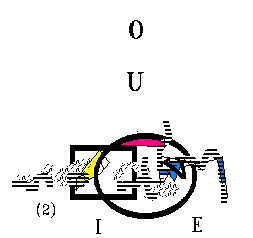

Universal Net Cubism®
by Clark Webly
also: http://rhizome.org/object.rhiz?3132
Practice - The first steps
Basis Element a
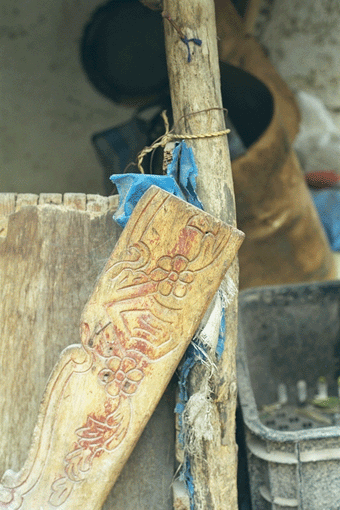
Universalization 1 - What Picasso did not see
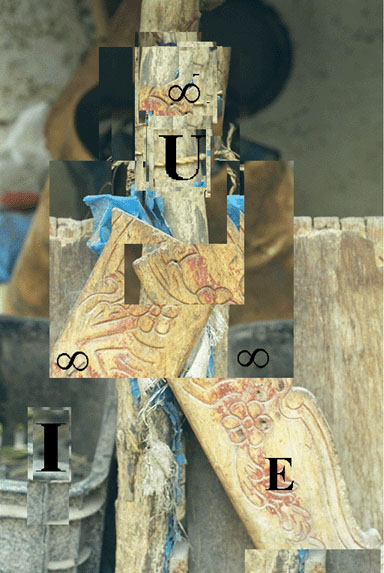
Animation Sample 1
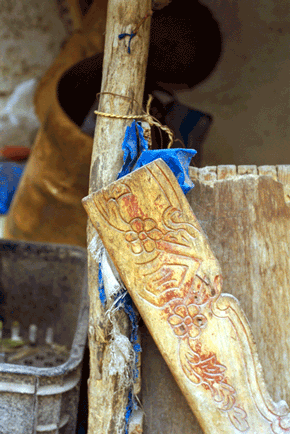
Animation Sample 2
New Element b
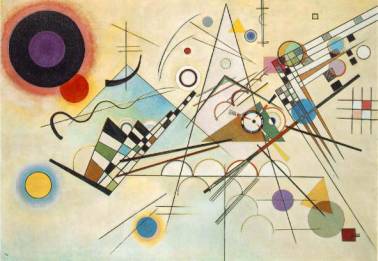
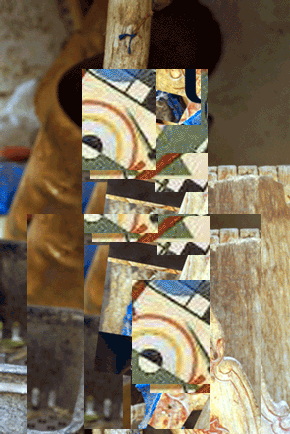
Animation Sample 3
Formal deductive elements of Universal Net Cubism®

Sample 4
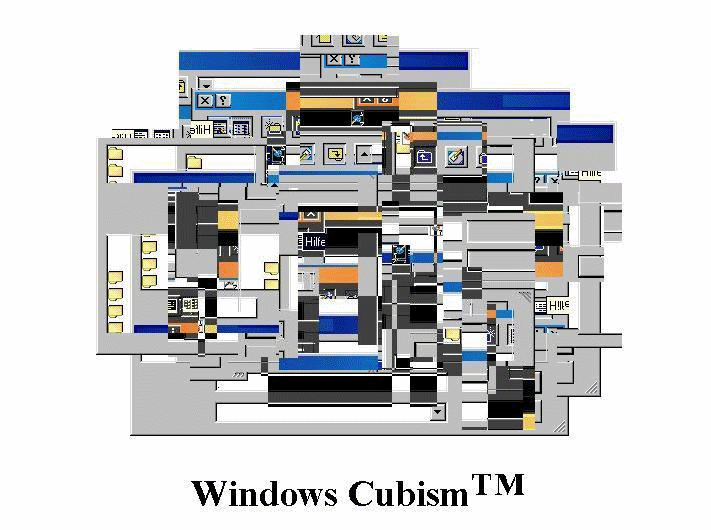
History
Cubismhighly influential visual arts style of the 20th century that was created principally by the painters Pablo Picasso and Georges Braque in Paris between 1907 and 1914. The Cubist style emphasized the flat, two-dimensional surface of the picture plane, rejecting the traditional techniques of perspective, foreshortening, modeling, and chiaroscuro and refuting time-honoured theories of art as the imitation of nature. Cubist painters were not bound to copying form, texture, colour, and space; instead, they presented a new reality in paintings that depicted radically fragmented objects, whose several sides were seen simultaneously. Cubism derived its name from remarks that were made by the painter Henri Matisse and the critic Louis Vauxcelles, who derisively described Braque's 1908 work "Houses at L'Estaque" as composed of cubes. In Braque's work, the volumes of the houses, the cylindrical forms of the trees, and the tan-and-green colour scheme are reminiscent of Paul Cézanne's landscapes, which deeply inspired the Cubists in their first stage of development, until 1909. It was, however, "Les Demoiselles d'Avignon," a work painted by Picasso in 1907, that forecast the new style; in this work, the forms of five female nudes became fractured, angular shapes. As in Cézanne's art, perspective was rendered by means of colour, the warm reddish browns advancing and the cool blues receding. The period from 1910 to 1912 often is referred to as that of Analytical Cubism. Paintings executed during this period showed the breaking down, or analysis, of form. Right-angle and straight-line construction were favoured, though occasionally some areas of the painting appeared sculptural, as in Picasso's "Girl with a Mandolin" (1910). Colour schemes were simplified, tending to be nearly monochromatic (hues of tan, brown, gray, cream, green, or blue preferred) in order not to distract the viewer from the artist's primary interest--the structure of form itself. The monochromatic colour scheme was suited to the presentation of complex, multiple views of the object, which was now reduced to overlapping opaque and transparent planes. These planes appear to ascend the surface of the canvas rather than to recede in depth. Forms are generally compact and dense in the centre of the Analytical Cubist painting, growing larger as they diffuse toward the edges of the canvas, as in Picasso's "Portrait of Ambroise Vollard" (1909-10; Pushkin Fine Arts Museum, Moscow). Paintings frequently combine representational motifs with letters, the latter emphasizing the painter's concern with abstraction; favourite motifs are musical instruments, bottles, pitchers, glasses, newspapers, still lifes, and the human face and figure. Interest in this subject matter continued after 1912, during the phase generally identified with Synthetic Cubism. Works of this phase emphasize the combination, or synthesis, of forms in the picture. Colour assumes a strong role in the work; shapes, while remaining fragmented and flat, are larger and more decorative. Smooth and rough surfaces may be contrasted with one another; and frequently foreign materials, such as newspapers or tobacco wrappers, are pasted on the canvas in combination with painted areas. This technique, known as collage, further emphasizes the differences in texture and, at the same time, poses the question of what is reality and what is illusion in nature and in painting. While Picasso and Braque are credited with creating the new visual language, it was adopted and further developed by numerous painters, such as Fernand Léger, Robert and Sonia Delaunay, Juan Gris, Roger de la Fresnaye, Marcel Duchamp, Albert Gleizes, and Jean Metzinger. Though primarily a style associated with painting, Cubism also exerted a profound influence on 20th-century sculpture and architecture. Chief among the sculptors who worked in this style are Alexander Archipenko, Raymond Duchamp-Villon, and Jacques Lipchitz. The adoption of the Cubist aesthetic by the architect Le Corbusier is reflected in the shapes of the houses he designed during the 1920s. |
Theory
What Picasso did not see
The Gruppe Or-Om© has demonstrated and deduced the position of all scools and tendencies in the evolution of Art in history within the Infinite and Absolute Essence. Each oeuvre of art has its special place in the Halls of the Universal Temple of Arts.
If you look at the general statements of the Gruppe Or-Om© about the Temple you will find the cubism in the Hall IIa, in the overlapping of forms belonging to Spirit (i) (yellow) and Nature (e) (blue). We have to state, that no artist involved in cubism so far, has recognized or seen the Total Structure of Cubism as elaborated by the Gruppe Or-Om©. History shows, that cubism was theoretically preformed by the clairness and the spiritual concepts of Cézanne and the dissolution of the central perspective. "Cubist painters were not bound to copying form, texture, colour, and space; instead, they presented a new reality in paintings that depicted radically fragmented objects, whose several sides were seen simultaneously". The emanicpation from traditional memetical, symbolic, literary and historical theories of art was on the one hand induced by geometrism, subjective and autonomous reinforcement of formal rules, not deduced and liberated from nature, but spiritual conceptualism and new feelings of balances and harmonies in composition of paintings and their syntax.
The Universal Temple of Art
i ... Universe of Spirit, e (yellow)... Universe of Nature (blue)
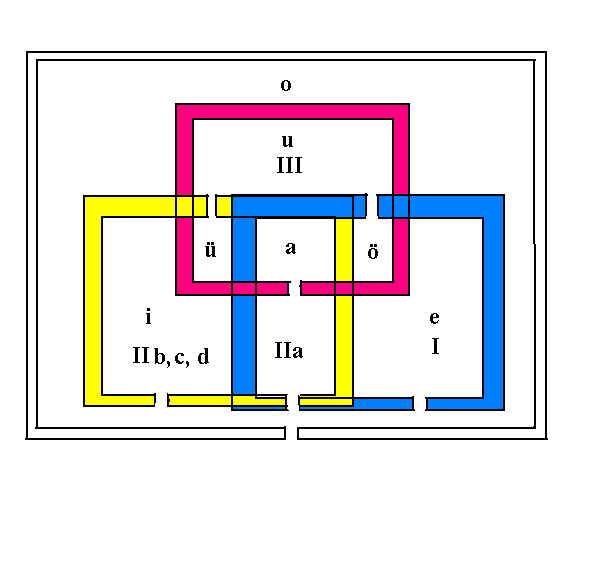
On the other hand we have to state, that traditional art since Renaissance has also integrated highly spiritual and even divine ideas in the symbolic and metaphorical contents and also in the theory of balance and harmony in the rules and the placement and quality of colors in its composition (look e.g. Gombrich Ernst H.: "Symbolic Images" 1972. London).
The Gruppe Or-Om© points out, that neither the artists in the Renaissance era nor Picasso and Braque have seen the structure of the Universal Concept of art, the contents, forms and formal rules of composition, which have to be derived from the Absolute Essence. Subsequently the former cubists have also not recognized the principles of the perfect Universal Net Cubism®. Their oeuvre is as far as that goes imperfect, and can be evolved to a new step of perfection.
Priciples of Universal Net Cubism®
At present only available in German.
The basics of the Universal Net Cubism® are elaborated in Robert Merling's: "Painting out of Future. Theory of Deductive Art©". Here only the headlines:
Evolution of Arts (Luc Burg: The VR-Space-Model of Universal Art); Deductive Art® and History
Relationship between the Universe of the Divine Essence, Universe of Spirit and Universe of Nature
Categories of Space and Time (Peter Paul Sarnig: Human Mind and AI)
Basical Forms (Sample 3)
Canon of Forms and Infinity (Ernst Riemschneider: Deductive Art®)
Types of Lines
Contrarity of Male and Female
Doctrine of Colours
Transformation of traditional cubism
If these pricpiples are introduced into theory and practice of cubism, its traditional parameters are transformed to a new evolutional step and transgresses former limitations.
Traditional cubism, working at the interface between formal principles coming from spirit and nature reduced its content to landscape, still life and portrait.
Universal Net Cubism® extends its content to all forms in the Universe of spirit and the Universe of Nature and all forms of the their interface (look at the Universal Temple of Art). Universal Net Cubism® recognizes the position, hierarchy and deduction of all these forms within the Absolute Essence. The rules of composition, variation, arrangement of formal elements are derived from a new law of the structures of beauties and harmonies of the Infinite Essence, Nature and Spirit and their interdependencies. These principles are elaborated by members of the Gruppe Or-Om© according to the Doctrine of Essence and its Basic Science founded by Karl Christian Friedrich Krause (1781 - 1832).
Is Universal Net Cubism® net art?
The technical standards of the Internet are magnifying the graphical possibilities to realize the infinite formal and contextual implications Universal Net Cubism® is gaining by the transformation mentioned above. Is it possible to say, that net art can elaborate a specific evolutive kind of cubism, or is Net Cubism® only the reproduction and repetition of art principles, created in traditional art theory within portals of the new media. Is it a kind of remediation, the reconfirmation of contents presented in older media now in newer media, the representation of cubism in former familiar media in new, less familiar media?
The ongoing discussion on this item has no precise results. "The interweaving of new technologies with pre-existing ones has triggered a kind of turbulent zone" (Jay Bolter). What counts as net art? asks Mark Tribe in the interesting email discussion developed among the judges for the 2001 Webby Award http://www.webbyawards.com in the Arts category. The category should be limited to net art projects as opposed to other kinds of art sites about net art. What are the essential formal characteristics intrinsic and immanent to net art? The discussion culminates in the question of Christane Paul: "In how far is HI ( http://www.yhchang.com ) different from all experimental and more abstract short filmes that use text and music? Why aren`t we considering Photoshop art, distributed via the Web? Because HI employs moving images? [....] I do not understand what makes HI net art other than its distribution medium (it`s one of many experimental movies using text and images and its main accomplishment in my opinion consists in the rhythm of text and music it creates. If there would be a category for flash movies and experimental short film on the Web, fine, that`s where it belongs and should get an award. HI is a very accomplished site of flash movies but has none of the qualities that distinguish net art from more traditional forms. Mark Tribe`s opinion: "I feel confidently placing HI in the net art category largely because that is where it has been contextualized in practice. I believe it was intended to be experienced as (cinematic) net art, not as web cinema. I have always seen it as contemporary art, and it has been talked about as such on Rhizome and, I assume, elsewhere. Lots of contemporary art practices, net art included, blur the boundaries between disciplines. As we know since Duchamp, art is what which we think of as art."
Rhizome ArtBase defines net art as artwork that uses the net as a medium and is made to be experienced online ( http://rhizome.org/artbase/ ).
Has Net Cubism® net art qualities, that distinguish it from more traditional forms? In other terms: Has Net Cubism® new qualities and elements enough to be accepted as net art? Following Mark Tribe`s criteria: Net Cubism® is net art, if we can think of it as net art. Is Net Cubism® net art in so far as containing and using elements, techniques of composition and rules, which could not be executed by other media as f.e. painting and film?
We will try to find a catalogue of criteria, which demonstrate the strong new qualities, which transcend the traditional frame of cubism in the "turbulent zone" of the interweaving of new animation technologies and pre-existing techniques of painting.
Sample 1-4 should figure as examples to check the criteria.
Sample 1
The animation contains a certain amount of (principally infinite) variations of one theme, integrated into a sequence of the basis element. What are the new, different criteria and possibilities?
I Universalization of form and content mentioned in the theory above as extension;
II Processual aspects
a) Unlimited acces to formal material within spirit and nature (matter) and their interface, by means of scanning of fotos, reproduction of traditional art products, not only paintings but also architecture, plastic etc., pictures of CAD and grafic software (e.g. Sample 3), Screen shots of any kind of websites (e.g.Sample 4) as basic elements for cubistic transformation and variation. The universal formal canon is completely available,
b) infinite possibilites of variations of the basis element.
c) precise integration of the variations (saved as layers within series of frames), defined by coordiantes in time and space;
c1) definition of the coordinates in time and space for each variation by geometric and rhythmical structurizing of the sequences;
c2) precise possibilities of repetition of the sequence of variations, precise permutation of the sequence of the variations etc.;
c3) precise permutation of geometrical and rhythmical structure of the variations;
d) creative possibilties of permutation of each elemtent (variation etc.) by the powerful tools of graphic software ( working with color, producing consistent color, color and tonal adjustments, selecting, transforming and retouching, using channels and masks, using layers, applying filters for special effects, inversion, distortion, rotation, using type etc.);
e) precise integration of elements of sound sequences (Flash tools), correctly related to graphical elements, "symphonic" integration of partial sound elments into the overall main theme;
e1) transforming of a graphical element into a seqence of sound and parallel reproduction of the two sequences;
f) technical possibilities of digital saving of all elements, layers and frames separetely. Saving of all these packages as raw material for new creations;
g) combination of all created and saved elements with new other themes, basis elements as shown in Sample 2, where sample 1 is combined with a basis element b derived from a painting of Kandinsky.
h) possibilities of precise reproduction and distribution by down-loading from the Website, by CD-ROM and other saving medias, by transforming into digital films and TV sequences.
Is this list sufficient to demonstrate the completely new dimensions and aspects of Universal Net Cubism®? We have to compare the results with a single picture of a cubist painter. It consists of a single constellation of forms and colors with a certain content. It is a complex condensation of the subtle creation process of the painter. He had stopped the process at a certain point. (Normally) he wanted to stop the process at a certain point. If he wants to variate the basis theme by creating and integrating new elements, he has to do it at a new canvas. Imagine how complicate it would be, to recreate and reproduce the similar basis theme. It seems to be impossible.
Is Universal Net Cubism® specific net art or only the transformation of traditional cubism into the surface of the internet? The answer seems to be clear. But one aspect is still remaining undetermined. Would it be possible, to realize all the net possibilities of cubism mentioned under I an II also in the media of film?
We say, that it is practically impossible. Imagime the challenge!
(Georges-Henry Clouzot made the film:"The Mystère Picasso" about Picassos creation process, by showing sequences of certain stages, phases and points of the ongoing work. But is this the same, we listed as the possibilities of Universal Net Cubism® under I and II. Obviously not!)
Apart from the Universalization (I) imagine the requirements to realize such a film without using the tools mentioned under II, about the processual aspects.
In comparison with Universal Net Cubism® we can be sure that the traditional possibilites of film are not able to fulfill all the criteria, realizeable by the abovementioned creative ressources (I and II) of net editors in combination with grafic software and their geometrical and mathematical meta capacities and tools.
We cite another sample. The Interactive Selfportrait by Christian Rupp:
http://www.christian-rupp.com/iselfpor.html
It is definitlely impossible to realize this cubistic artwork in the medium of film! The technical details and the interactivity are belonging exclusively to the medium of net technologies.
The door to new horizons of net art is opened!
